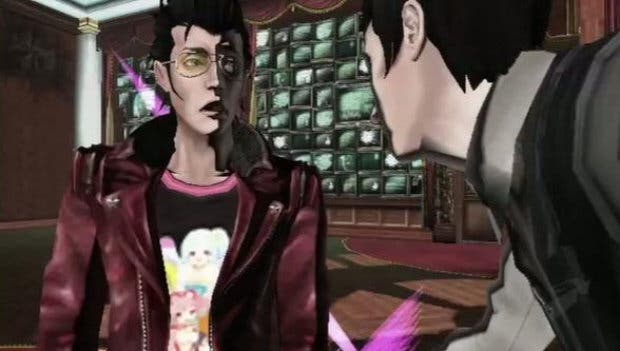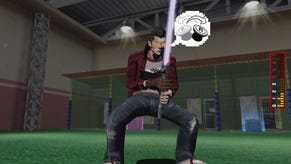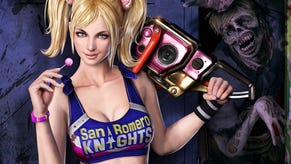No More Heroes 2: Desperate Struggle
Beaming.
Nathan Copeland, a 7-foot African-Irish breakdancer voiced by the bastard child of Liam Neeson and Samuel L. Jackson, slouches heavy on a leather couch. He is framed centre of a widescreen window in an office apartment at the top of a skyscraper in which people who earn more money than you go about earning more money than you. On either arm purrs a lithe, olive-skinned twin. They have matching afros, skimpy swimwear and the sort of high heels that make you proud to be a biped.
The lift doors carrying Travis Touchdown to the unlikely scene tsshck apart, and he steps out, aviator sunglasses masking quick eyes. Nathan Copeland holds the silence for a second before rising to his feet and using the momentum to lift the twins into the air. In a single arcing motion he hurls them at Travis Touchdown, who steadies himself against the incoming fleshy projectiles by placing his weight onto his back foot and firing his beam sword to humming, luminous readiness. Catching the twins mid-trajectory, Travis flurries his weapon back and forth across their twitching bodies, each suspended in midair by anime cliché.
Nathan Copeland leaps in slow motion towards the scuffle, his arms turning into two oversized ghetto-blasters as he does. The scene freeze-frames for a moment and the orchestra ducks sheepishly under the silence. Nathan and Travis catch eyes and the camera drops like a yo-yo to the floor, just in time to catch the coconut donks of two identical lipstick-wearing heads drop torso-less in front of it. Beat.

The world un-pauses and No More Heroes 2's director Goichi Suda presses the beam sword into your palms. Three minutes later, or however many continues it takes you, Copeland is vanquished. Travis Touchdown has cleared the second boss on the road to revenge and, perhaps more pertinently for his pubescent players, to the knickers of the pretty French girl who's promised you maybe-sex should you defeat them all.
If Dante's Inferno sought inspiration in 14th Century Catholic nightmares, then No More Heroes 2 peers into the wet dreams of every 14-year-old boy with a boner and a power fantasy. The result is no less fearful, but, if approached as a celebration of juvenility rather than evidence for its condemnation, far more enjoyable.
It mixes toilet humour with lightsabres, decapitation with banal one-liners, themes of stiff-lipped revenge with themes of pet care, Telecaster riffs with violin soliloquies and John Woo action mechanics with Famicom-aesthetic mini-games. And somehow, in amongst all of the confusion and tension and mess, a videogame of coherent vision and engaging execution emerges.

All of this, of course, was true of the first game, Suda 51's two-fingered punkish salute to who-knows-what. GTA seen through a glass darkly, Travis Touchdown's debut was structured around 11 wonderfully diverse boss fights, interspersed with visits to clothes shops, the gym and the job centre. It was a glorious hotchpotch of design ideas, a 200 rpm spin cycle of adolescent rampage and perhaps the closest that gaming has come to its Never Mind the Bollocks, full of filth, fury and impotent anti-establishment sentiment.
This sequel borrows the framework unquestioningly (upping the number of boss fights to 15), but strips out much of the mess that muddied the debut. Gone are the vast majority of the awkward biking sections that delivered Travis to and from his jobs, in their place a simple, understated menu system overlaid onto a town map, each destination a mere click away. Via this interface you buy new clothes for Travis to flounce around in ahead of his next fight, or toddle home to play with your vastly overweight cat (who, like Professor Layton's hamster, desperately needs a calorie intervention).







